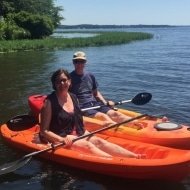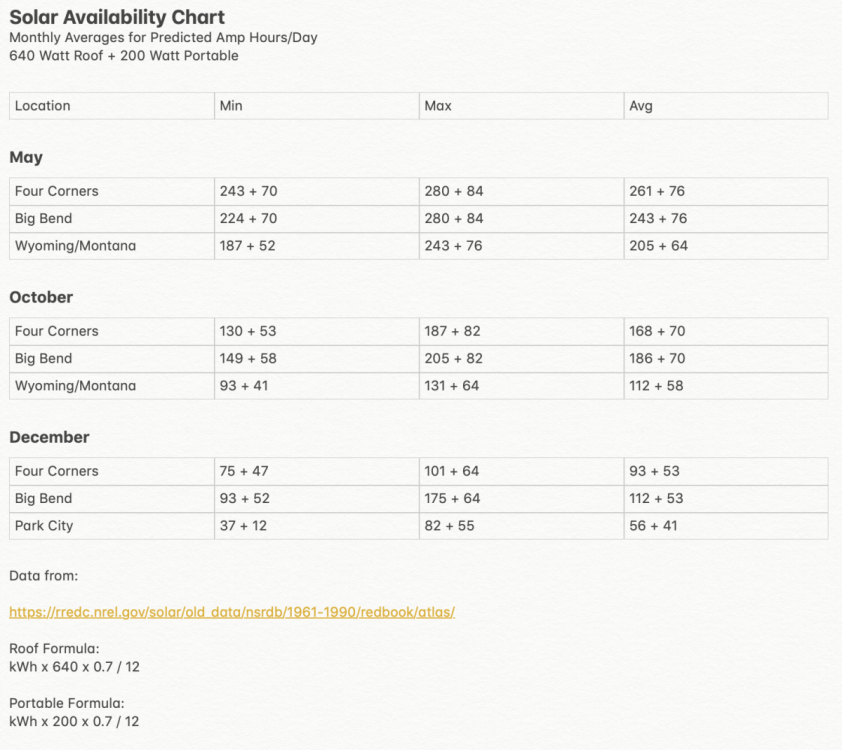Leaderboard
Popular Content
Showing content with the highest reputation on 08/22/2020 in all areas
-
I've been curious about towing mileage of various vehicles. So, I did a search for gas, diesel, and mpg in the forum archives for reference since 1/1/16. The graph below shows the minimum mileage, average (mean) mileage, maximum mileage, and the number ("n") of references. For vehicles with only one reference, the maximum, average, and minimum values are the same. The references that I found cover a range of conditions (speed, terrain, temperature, etc.). Because of this, and because of the small number of listings for most vehicles, the results are anecdotal and not statistically significant. Nonetheless, in aggregate they provide some indication of what one might expect for towing mileage. The results are probably not surprising: (1) half-ton diesels (e.g., ecodiesel) or diesel SUVs did best, (2) gas generally engines fall into the 10-13 mpg range, (3) 3/4 ton diesels seem to get 13-16 mpg. And, of course, towing mileage is only one consideration for selecting a tow vehicle. It is unlikely that I found all mileage references in the forum archives -- the search function doesn't seem to be entirely consistent in picking up the same references over multiple searches. I can expand this mileage compilation with additional data if the results would be useful to enough of you. If you'd like to submit mileage, please respond with the following information: trailer (i.e., LE1 or LE2), tow vehicle, year, engine, gas/fuel mileage while towing, gas/fuel mileage while not towing, the number of miles over which you are estimating the gas/fuel towing mileage, typical travel speed, and the region of the country in which you travel (e.g., NE, SE, midwest, west). I realize that there are lots of other variables (e.g., transmission, axle ratio, vehicle modifications, etc.), but accounting for these becomes too complicated.2 points
-
We just got back from a few weeks in Colorado and northern Arizona. The pandemic does make things less fun. We visited a couple of National Monuments outside of Flagstaff and masks were required, the visitors centers were closed to the public. If you wanted to purchase any kind of souvenir you had to visit an outdoor table and point to what you wanted and a ranger or volunteer would go inside and get it for you. We found ourselves not stopping to see certain things, just not as much fun. Hopefully our Lake Guntersville/TN/KY trip will be a little better. But, it was still good to get out on the road and away from this south TX heat for a while!2 points
-
On earlier versions of this fan there is a thermal fuse taped to the side of the fan motor. If the motor became jammed, this fuse should melt before permanent damage to the motor occurred. On the latest versions, this fuse has been replaced by a fusible wire for the positive pigtail. Either way, neither scheme is serviceable with readily available parts so the entire motor is replaced. Available replacements come with the newer style overload protection and directions that address either style. With an earlier version, you'll need to access the splice connection at the trailer wiring so the original motor pigtail can be removed and replaced. This means the entire assembly has to be lifted out of the hole. At least with an old versions one could MacGyver a replacement thermal fuse. Also, be aware that the plastic fan blade is pressed on the splined motor shaft. Getting it off requires substantial hand force. Best to plan on a replacement blade in case it gets damaged in the process.2 points
-
Yes, on a sunny day with no shade, your solar panels will likely recharge your batteries completely. How likely depends on a few factors but that’s probably a subject for a separate topic. With the vehicle’s stock wiring and no other modifications, your alternator will provide some charge but not a lot.2 points
-
Leave it as it is and you’ll be fine. The discussion above is only relevant if you rewire your truck with heavy gauge cables. It’s an important discussion, but it applies only to the very few people who want to modify their vehicle.2 points
-
High temp terminals are nickel plated steel and don't loosen with repeated temperature fluctuations like standard copper will. You'll find these in any UL household appliance where crimp terminals are used. They require a lot more force to crimp but result in a more positive connection where soldering isn't feasible. Big advantage of parallel over butt is they make for a shorter splice and work better in tight spaces. You can see this in Yukon's pictures. The white closed end crimps are internal fan wiring done by the fan mfg, not Oliver. Not being directly subject to heat from the motor, they are probably standard copper barrel terminals. Since the fuse is a thermal protection device, as opposed to current protection, it must be in direct contact with the fan motor.1 point
-
Thanks for putting that together. I'm sure it will be of help to a lot of people. I can give you mine, which is for the high output 3.5 ecoboost, which Ford is using in the Navigator and Limited F150 as well as the Raptor. I see 10 minimum and 13 max, typically 12-something, towing an LE2. The Raptor is the least aerodynamic of the F150's and has big all terrain tires that don't help either, so given that, I've been satisfied with the mileage I've seen. Just remember with your research that there are certain numbers that men always exaggerate, MPG being one of them. 😛1 point
-
Ok, thanks I figured as much always tend to the safe side. Ordered up the fuse now . Thanks for the 9V test, I am heading in the right direction now. Still could be the switch but I don’t think 🤔 so. I have some heat shrink butt terminal s from my boating days that should work for connecting. 👍🏻1 point
-
The wind turbulence from the fan blade blew mine loose. The seal is adhered to the lid with double-sealstick cellophane tape. In the heat of the sun it doesn't take long.1 point
-
This is great! I'm going to put the lithium charging worries aside and enjoy our RV travels 😄 All we need now is an Ollie . . . . . . We are selling our LTV Unity next week; will be three months without an RV - two of them the best camping weather! I tell myself, "that's ok" . . . . until this pandemic thing settles down, camping just isn't what it used to be.1 point
-
Does the original foam seal fail from wind turbulence from leaving the fan cover raised while towing? I tried that one time. Then I saw all the bug carcasses accumulating inside the front and decided to always close it when on the move. I don’t see why the foam would get displaced normally, but perhaps it freezes in winter and then tears. I see the “how” but I want to also understand the “why”. Perhaps a pretty aluminum Bugs Be Gone Fan Guard (Patent Pending) wind dam in front of the fan, tall enough to deflect the wind and bugs with the cover raised, could be a good mod....? 😬 A simple piece of aluminum 1x2” angle taped down would work as a prototype... hmmmm. I think I have a piece in my scrap pile. A deflector would also stop rain and water flowing off your TV from driving under the seal if you tow in heavy downpours. Checking under the cover is now one more thing to do when wandering up top looking at stuff.... John Davies Spokane WA1 point
-
My primary reason for the solar option was to replenish draw-down while traveling. So far, traveling 6 hours a day during mostly winter daylight hours, it has served it's purpose. Even on cloudy days I've found there will be some solar charge current produced. The vehicle charge line may assist to some degree but the only reason Oliver provides this connection at all is because the main batteries are used as the breakaway power source for the brakes. Applicable standards require this TV charge capability.1 point
-
This is an interesting conversation, I am learning a whole lot of new stuff. Would adding a second belt-driven “conventional” 200+ amp alternator be a solution? With a second power source you could keep it completely separated from the OEM electronics and computers. The truck would literally not even “know” what was happening through those new circuits. https://www.americanpowerinc.com/custom-alternator-brackets-and-dual-alternator-bracket-kits/#product-tab-description A huge bonus to this method is it most likely would not negatively affect your truck’s warranty. Running a huge charging load off your truck’s main alternator is risky. Many HD trucks have a factory dual alternator option (for use with snow plows or winches). I don’t know anything about these .... can somebody comment on how practical it would be to hack the wiring of the second alternator for dedicated trailer charging? John Davies Spokane WA1 point
-
I read Oliver's response as simply concurrence with Lifeblue's recommendation and wouldn't have expected much else. Whatever modifications are necessary for your TV and trailer wiring are your responsibility. IMO if you're customizing to this extent, best to lean more on the advice of battery and component mfgs, and those with first hand knowledge/experience.1 point
-
I don't think it matters while driving. Technically, I've read that most alternators are only about 50% efficient, meaning that half the energy going into them is turned into heat rather that electricity. But it's a small fraction of your engine's power that's used to drive the alternator.1 point
-
Figured out the bathroom fan failure was due to the sealing gasket Getting caught in the motor fan blade which intern burned out the fan motor. With Jason’s help . I was able to purchase a new motor from Amazon. All work is performed via outside by removing the cover. If you are not good on a ladder you may want to have someone do it. I am going to try a new type of gasket and see how that works. As usual poor quality and workmanship comes hone to roost. Oliver just installs the units and has nothing to do with the construction of the fan units.1 point
-
Hi all, Jason did respond back on this topic. He reached out to the R&D team at Oliver that has worked on the Lithium package and this team also recommended following LifeBlue's design that has been shared and discussed in the forum (Oliver calls it a kit). Here's what I'm going to build and mount on top of my Ollie someday when I get the spare time... having the alternator closer to the batteries makes everything so much easier! 😉1 point
-
One of our favorites, too. The view from the campsite isn't much, but, omg, the views from the restaurant at Pisgah Inn across the road. In the morning. Breakfast view through the floor to ceiling windows is amazing. Layered mountain views seem to go on forever. Even if breakfast weren't outstanding (which it is), it would be worth the price just for the views.1 point
-
Actually I misspoke. Our inverter only serves the outlets so even if I wanted to run AC with batteries and inverter I couldn’t. Maybe other configurations have different circuits served by the inverter. That is ok with me - we have the AGMs but I would not want to run the AC if dry camping because I would want to save the battery capacity for other things. If I wanted to run AC without shore power I would run it with a generator. We don’t have solar. Increased battery capacity is nice - I just don’t see it as a solution to running AC in normal situations1 point
-
This is the chart I made for our system. Divide by 2 for a typical Ollie setup: So, yeah. Realistically, if we're talking 300Ah of batteries and people people freak when their batteries hit 50%, we're talking about an hour and a half of AC use. In most situations, once you include your other uses, the average Ollie owner could plan on the better part of two days of sunlight to recoup that. Average - if it's truly mid summer, four corners, zero clouds, you could possibly get it back in a day. If it's cloudy, might be three. I've said many times - it's not magic. AC units have tremendous appetites and solar output is one of the most exaggerated topics in the RV world, both from dealers and owners. Solar is great, LFP is great, but there's a reason my trailer looks like an aircraft carrier.1 point
-
ShallowGal had to replace a thermal fuse on the the B+ wire at the bath fan earlier this year. The MaxxAir fan still worked because the bath fan and rectifier diode is at the the end of that circuit. You mentioned that you did not test the fan, but did you test the power supply at the the fan? Mossey0 points
-
Recent Achievements














